Korean Sushi Rolls, also known as Kimbap, are a vibrant and delicious alternative to traditional Japanese sushi. Packed with savory fillings like seasoned vegetables, meat, and eggs, all rolled up in seaweed rice, Kimbap offers a delightful explosion of textures and flavors in every bite.
This recipe makes Kimbap at home easy and approachable, using ingredients you can easily find at most grocery stores.
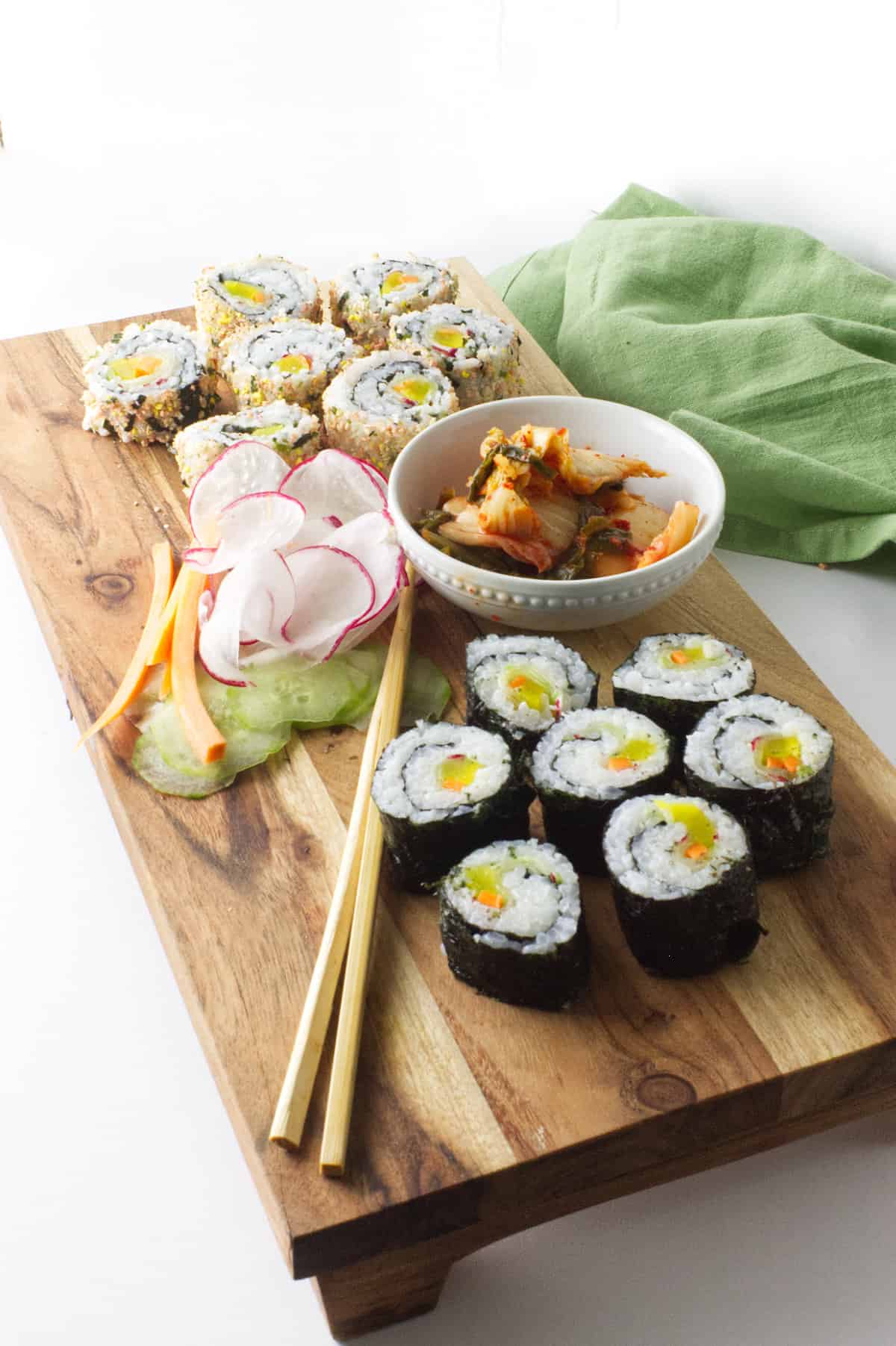
What is Kimbap?
Kimbap is a traditional Korean dish that is often referred to as 'Korean sushi', but there are some important differences between the two. Kimbap (also spelled gimbap, 김밥). Originated centuries ago in Korea's Gija Joseon era.
Kimbap rolls are an incredibly popular snack or meal that has only grown more popular over time due to its unique and flavorful combination of ingredients. If you love sushi, than you need to try Korean 'sushi' rolls.
Today I'm going to show you how to make both easy kimbap rolls and inside out kimbap rolls.
Why You'll Love This Recipe
Also known as "Korean sushi", Korean seaweed rolls are fast and easy to make. Kimbap rolls are made with cooked short-grain rice, carrots, daikon pickled radish, and other veggies or meats rolled inside roasted seaweed (gim) for the perfect combination of taste and texture.
Kimchi 'sushi' is probably one of the simplest kimbap recipes, as it is just seaweed paper rolled up with sesame oil flavored rice and kimchi. I could buy them on the street for the won equivalent of about .70 cents when I was living in Korea.
Ingredients You'll Need
You'll need cooked short-grain rice, sesame oil, salt, toasted sesame seeds, a sheet of roasted seaweed (gim), and your choice of fillings like julienned carrots, spinach, thinly sliced ham, cooked egg strips, and imitation crab sticks.
For The Korean Kimbap Rice
- Short Grain rice - Often called Calrose rice.
- Sesame oil - Get the toasted sesame seed oil sold in the Asian food aisle.
- Salt
For The Kimbap Rolls Filling
- Carrot - Peeled, trimmed, and grated or julienned (cut into thin strips).
- Cucumber - Peeled, cored and sliced paper thin, or julienned.
- Red Radish - Cut paper thin slices.
- Pickled Daikon radish - look for the bright yellow, vacuum packed, pickled radish in the Asian food aisle or any Asian food market.
- Furikake - A dried fish, sesame seed, and salt garnish.
- Dried Nori Sheets - Gim sheets, Laver sheets, Nori sheets, or seaweed sheets - you may see these 10" square sheets of dried seaweed paper under a variety of names.
Optional Filling Ideas:
- Green Onion - Cut the green onion strands into long thin slivers.
- Egg Strips - Make an egg pancake with a beaten egg, then cut 'noodles' about ¼" wide.
- Cooked Beef Bulgogi - cut into strips about ¼" wide.
- Spam - cut into slices, then julienne.
- Cheese - The best cheese to make julienne strips from is Cream Cheese, but Velveeta can also be used.
Full ingredient amounts and preparation instructions are in the printable recipe card at the bottom of this post.
PRO TIP: Don't try to use ALL of these fillings in a batch of Kimbap. Just pick about 2 to 3 items max.
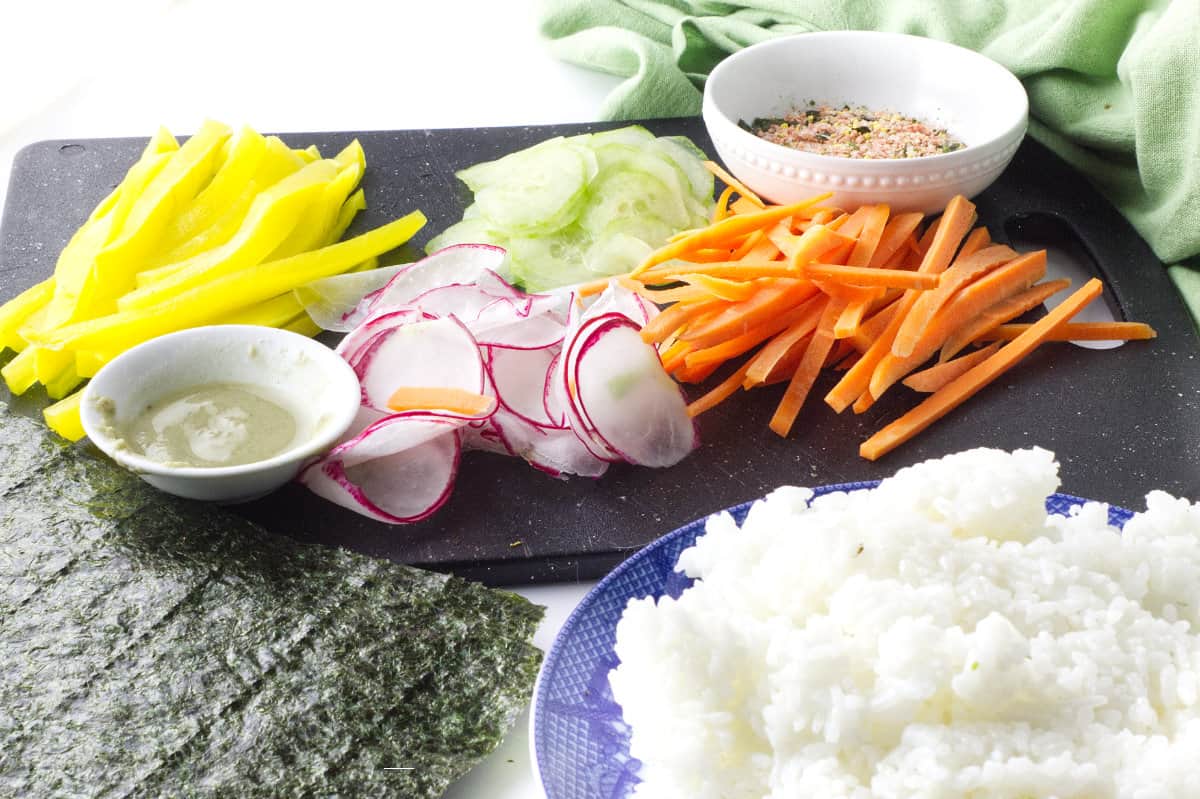
How To Make Korean 'Sushi' Rolls
Kimbap is a traditional Korean dish that is often referred to as 'Korean sushi', but there are some important differences between the two. Originating centuries ago in Korea's Gija Joseon era, kimbap is an incredibly popular snack or meal that has only grown more popular over time due to its unique and flavorful combination of ingredients.
Let's dive in and unlock the secrets behind these traditional Korean delicacies.
Prepare The Rice and Vegetables
- Make some short grain rice either using our stove top Steamed Rice recipe, or with a Rice cooker. See our Aroma Rice Cooker Rice Recipe.
- Once cooked, toss the hot rice in a bowl with a drizzle of sesame seed oil and let it cool by spreading it out.
You can use whatever vegetables you have in your crisper, like green scallions cut into long slivers, grated or julienne carrots, thin slices of red radish, and cucumber sliced in thin circles, or cored and cut into strips.
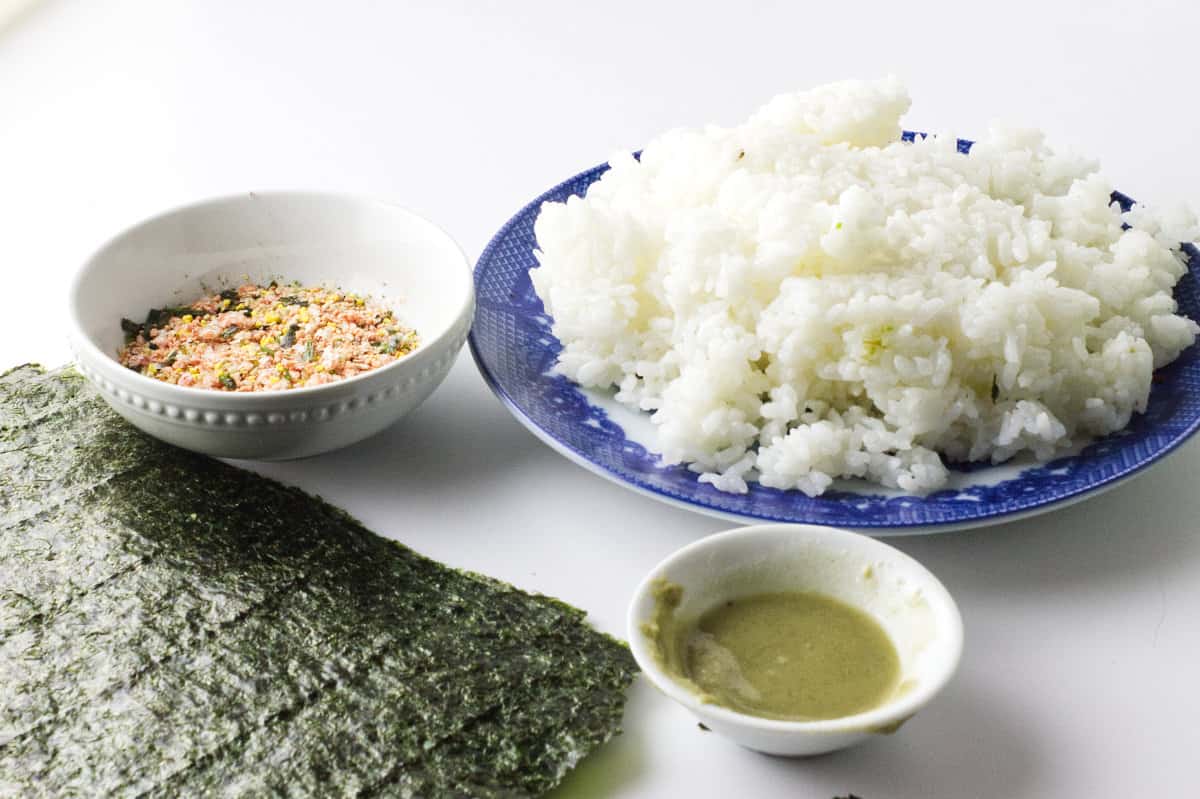
Bowl of cooling, sesame oil tossed rice, Furikake garnish, and some wasabi sauce.
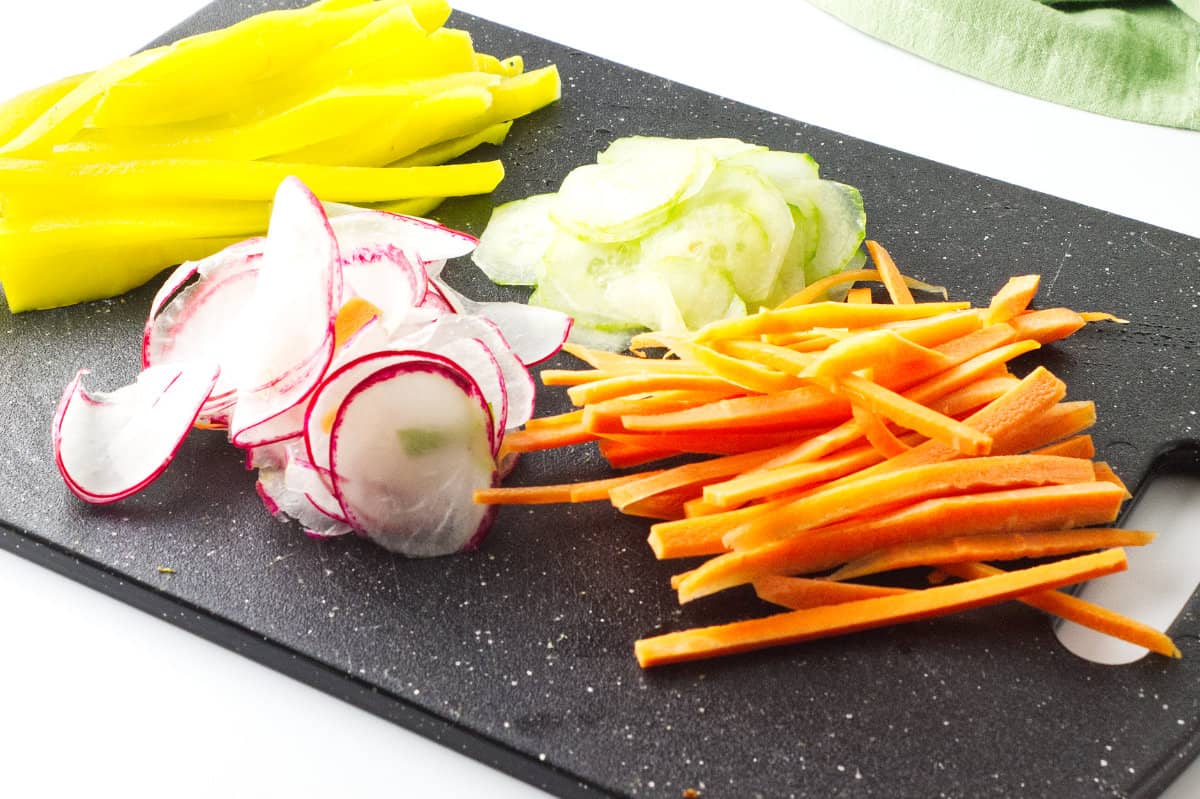
Julienne carrots, paper thin cucumber and radish, and thin strips of pickled yellow daikon radish.
Other ingredients typically rolled up in Korean 'sushi' rolls are: thin pieces of grilled bulgogi meat, strips of egg pancake, raw fish, and even cream cheese.
If you have a jar of kimchi, you can add a little to these Korean seaweed rolls also.
Roll The Kimbap and Slice
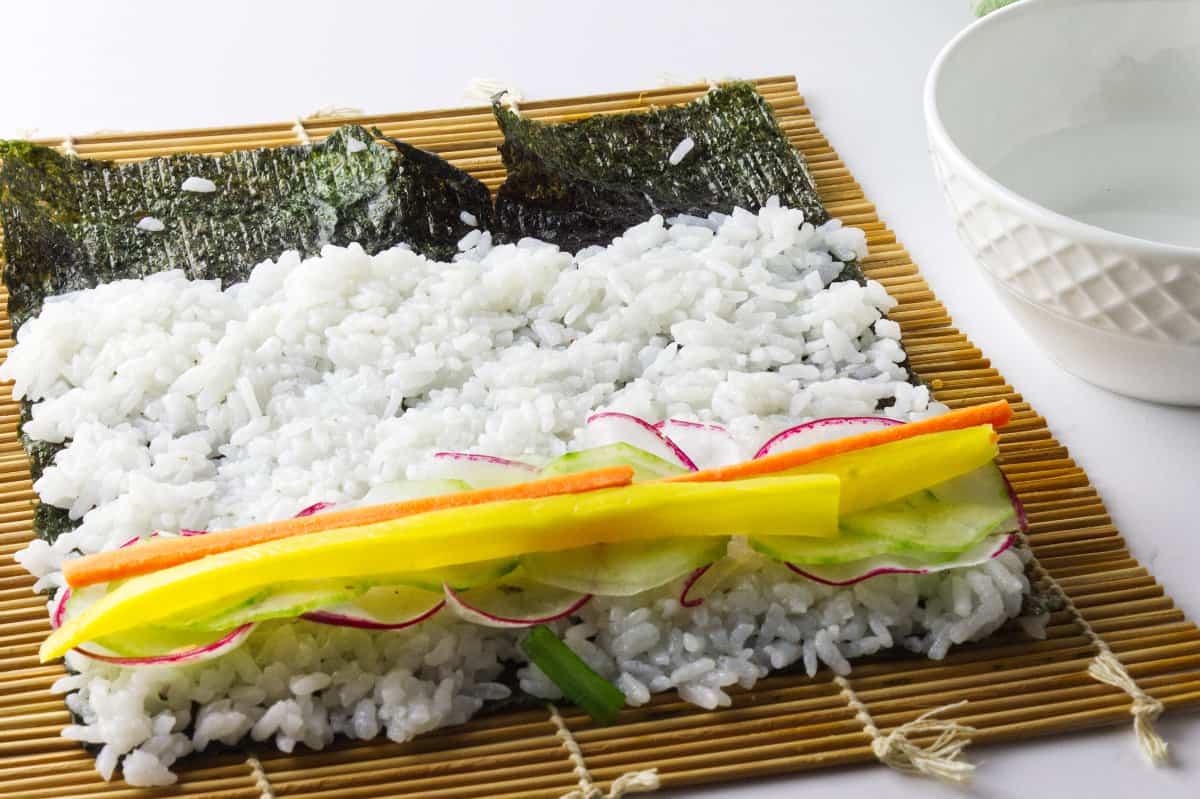
- Spread rice thinly over a sheet of seaweed. Add the vegetable filling in a straight line across the end closest to you.
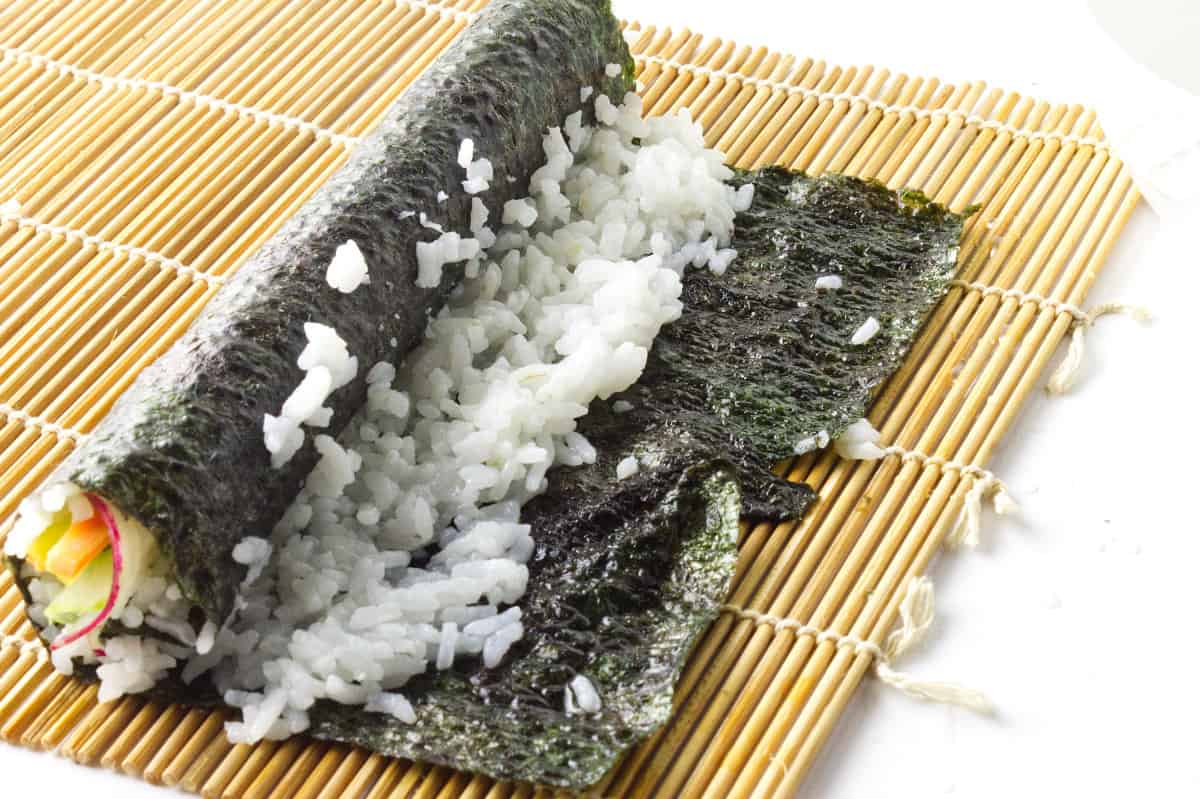
- Use the sushi rolling mat starting at the end closest to you. Pull the mat back as you roll the kimbap up. The vegetable end will be the center.
Roll Up Tight
- Once you have rolled the kimbap up completely it will need to be pressed. That means you will place the roll at one end of the sushi mat and roll it back up very tight. Let it sit for a moment so it adheres. Then unroll
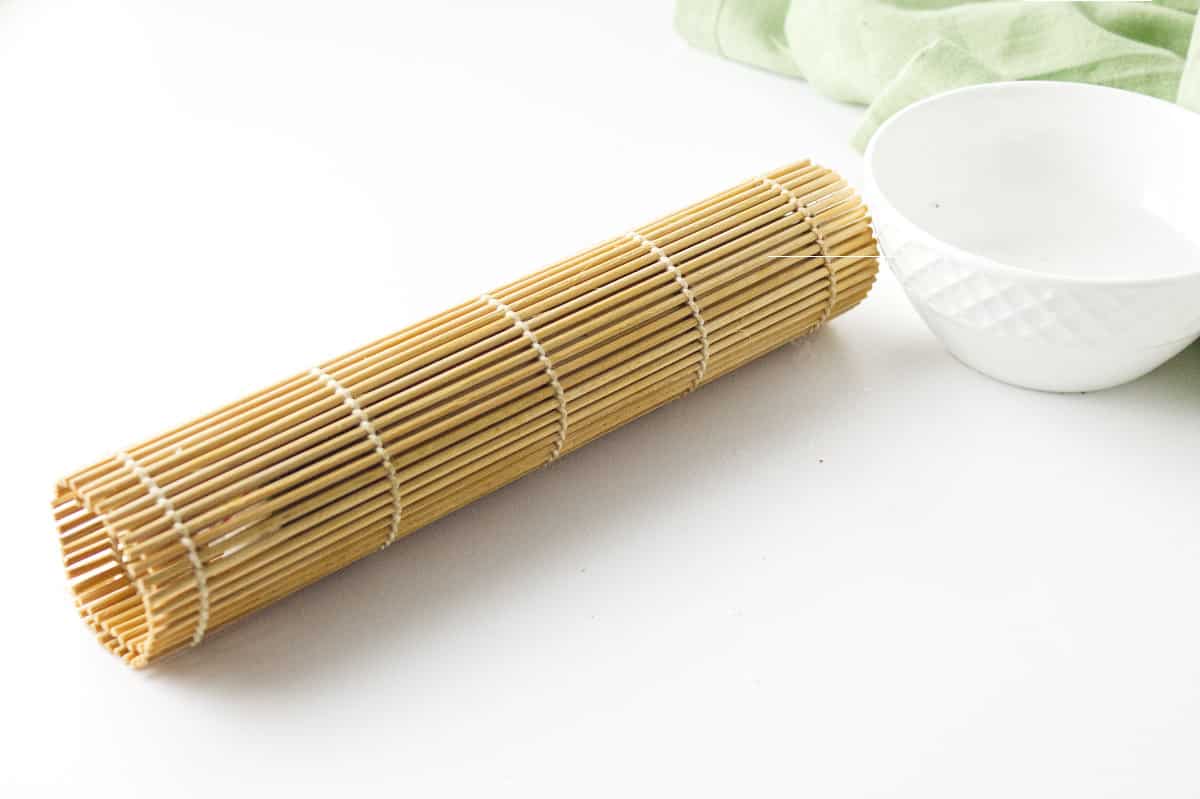
Kimbap rolled up tightly so that the seaweed sheet holds the roll together.

This kimbap roll is ready to slice and serve now!
- Unroll the Sushi mat. Slice the kimbap roll and serve with some Kimchi.
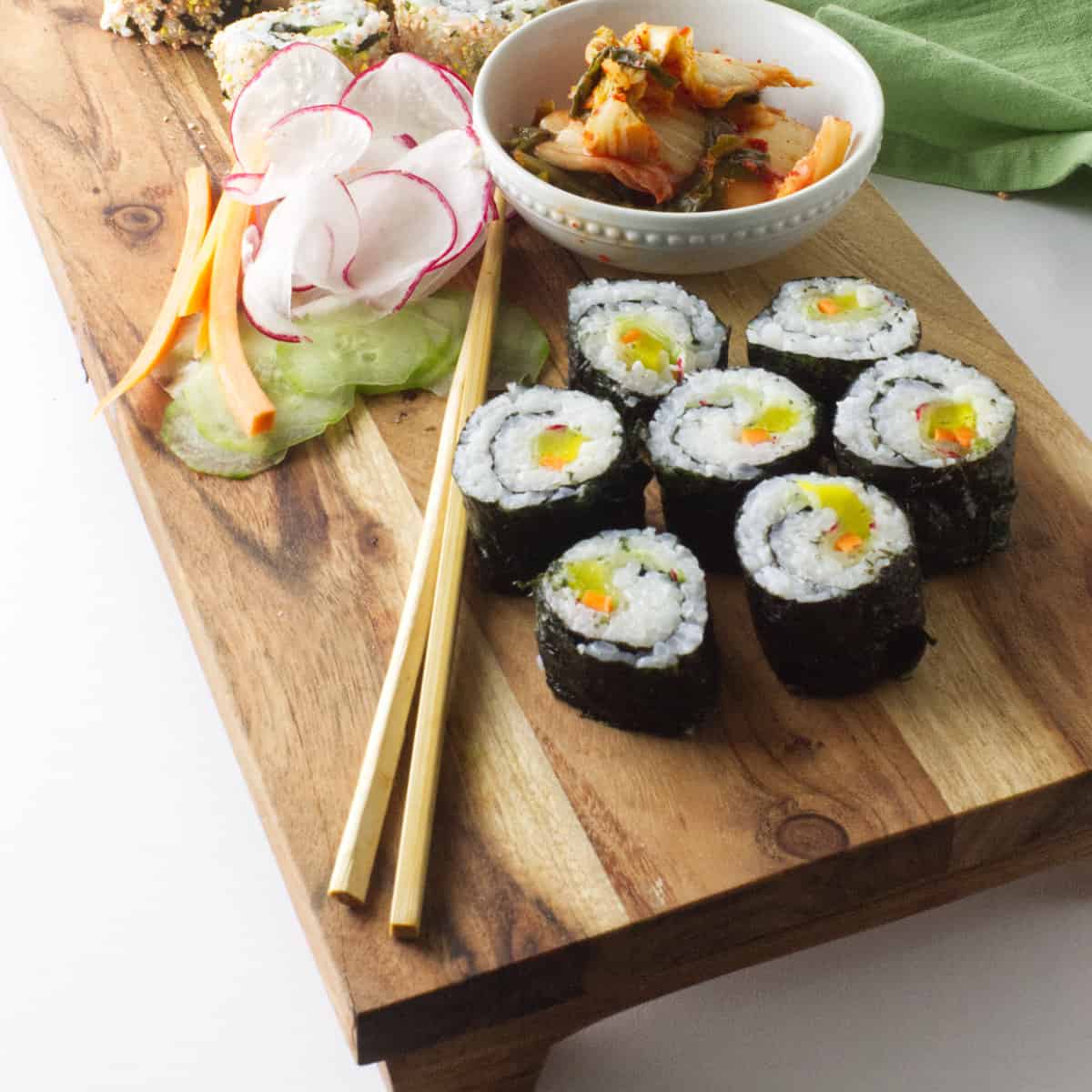
Serving Suggestions
Kimbap is an absolute classic of the Korean kitchen – serve as a traditional snack or light meal option, or as part of a picnic or on-the-go lunch.
Kimbap can be served with Kimchi, Korean Bulgogi, Edamame Cucumber Salad, our Bok Choy Soup, and much more. Try it as an appetizer also with our Teriyaki Chicken Skewers and Steamed White Rice.
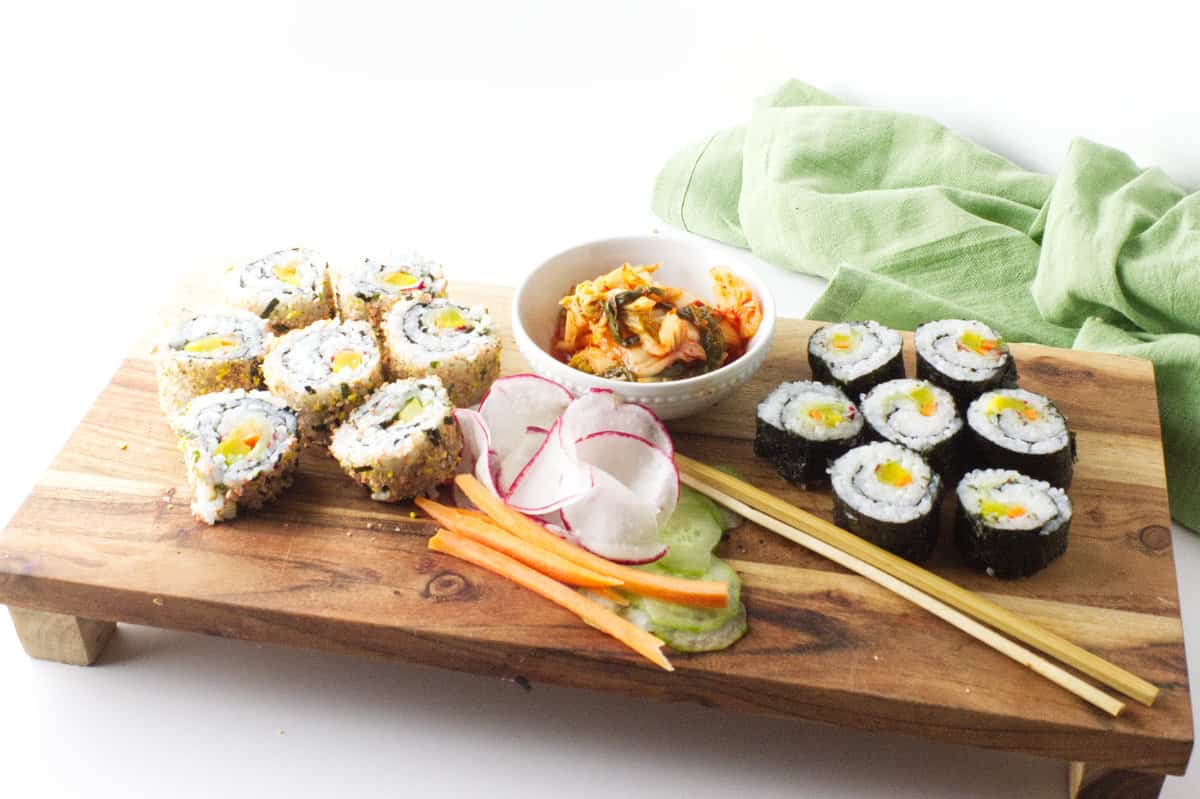
Related Recipes
Substitutions
- Kimbap can be easily adapted to a vegan diet. Stick with vegetables and ditch the egg pancake, bulgogi, and definitely the Spam!
Variations
Kimbap can be prepared in endless variations using a variety of ingredients such as roasted seaweed, pickled radish slices, egg omelet strips and cooked white rice.
Whether you opt for vegan-friendly options or try something more indulgent by adding fried egg and bacon bits to your mixture, this simple yet versatile dish promises deliciousness whatever combination you choose! Here are some favorite variations:
- Cheese Kimbap - If you love California Rolls, than you will also love Cheese Kimbap. Use Daikon pickled radish strips, the green strands of a green scallion, and slivers of cream cheese. Place down the center of the rice covered seaweed sheet and roll up using a kimbap rolling mat.
- Spam Kimbap - Spam and ham kimbap are very popular. Just make thin julienne strips and roll up with some cucumber and avocado strips.
- Tuna Kimbap - Fish is not typical with Kimbap, but there you have it, the hybrid sushi-kimbap creation. Cut the raw tuna into thin julienne strips.
- Vegan Kimbap - Just veggies. That alone is a wealth of variation. Avocado is amazing with a little bit of kimchi (made without fish sauce).
This simple yet versatile dish promises deliciousness with whatever combination you choose!
Equipment
Equipment can have a big impact on how a recipe turns out. The following supplies and equipment will make this kimbap a snap to make.
As an Amazon Associate I earn from qualifying purchases.
- Sushi Rolling Mat - be sure and get at least two, it makes inside out rolls so much easier to make!
- Short Grain Rice
- Pickled Daikon - you will have lots of leftovers. Vacuum seal and store in your refrigerator indefinitely. Try adding slices to your olive & pickle platters.
- Furikake garnish - this is a pulverized, dried bonita and sesame seed sprinkle. It's great on salads, rice, soups, you name it! Vegan varieties are available also.
- Seaweed Sheets - Korean seaweed sheets are called 'gim'. Rice is 'bap'. Kimbap - as we call it is actually Gimbap, or Seaweed Rice! You will see the seaweed paper sheets sold under a wide range of names: Laver, Gim, Seaweed, Sushi paper, or Nori.
Storage Options
- Korean sushi rolls will keep as rolls or sliced for up to 3 days covered if only vegetable or cooked meat based.
- If you use raw fish, eat them within 24 hours of making them.
Tips for Success
- Spread the rice much thinner than you think you should, as when rolled up it is compacted. This will keep your rolls more manageable when rolling up.
- Working with slightly warm rice is easier than cold rice.
- Spray your hands with non stick cooking spray, or use olive oil on your hands to prevent the rice sticking as much.
Frequently Asked Questions
Japanese Sushi features raw fish, seafood, vegetables, and rice seasoned with vinegar. Korean Kimbap rice is seasoned with sesame oil and doesn't contain raw fish. Instead, kimbap fillings include pickled daikon radish, slivers of vegetables, and sometimes meats like grilled bulgogi, cheese, kimchi, Spam slices, or eggs.
More Delish Ideas
Kimbap - Korean 'Sushi' Rolls
Equipment
- Sushi Rolling Mat Get two, your kids will enjoy helping!
- Pickled Daikon (cover leftovers and keep in the refrigerator indefinitly).
Ingredients
For the Rice
- 2 cups short grain rice
- 3½ cups water
- 1 teaspoon salt (for the rice pot)
- 1 tablespoon sesame seed oil toasted
- 1 teaspoon salt (for tossing with sesame oil and rice)
For the Kimbap Filling
- 1 medium Carrot peeled, trimmed, and julienned.
- 1 small Cucumber peeled, cored, and julienned.
- 4 Red Radish trimmed and sliced paper thin.
- 4" chunk Pickled Daikon cut into julienne strips.
- 8 sheets Seaweed Sheets
- 3 tablespoon Furikake any variety, for garnish
Instructions
For Kimbap Rice
- Prepare the short grain Calrose rice ahead of time by rinsing in a sieve until the water runs clear. Shake excess water off and add to a 2 quart pot. Add the water and the salt. Bring to a boil and then cover. Lower heat to low and cook for 20 to 22 minutes.2 cups short grain rice, 3½ cups water, 1 teaspoon salt
- Toss the hot rice with the toasted sesame seed oil and the salt. Spread out in a dish to cool a bit before handling.1 tablespoon sesame seed oil, 1 teaspoon salt
For Kimbap Filling
- Prepare the vegetables while the rice is cooking. Trim and peel the carrot and cucumber. Slice the cucumber in paper thin slices, or core and julienne. Cut the carrot into julienne strips. Trim the red radishes and slice paper thin. Cut a 4" chunk of daikon off and slice into thin julienne strips.1 medium Carrot, 1 small Cucumber, 4 Red Radish, 4" chunk Pickled Daikon
Rolling Regular Kimbap
- Place a sheet of seaweed on the sushi rolling mat. Spread rice over ¾ of the seaweed surface, very thin. Leave the ¼ portion of seaweed furthest from you bare. You may see spots of seaweed still. That's OK.8 sheets Seaweed Sheets
- Make a line of filling one ingredient at a time at the end of the rice covered seaweed sheet closest to you. Start with the cucumber slices, then radish, then strips of carrot and daikon.
- Grab the end of the sushi mat closest to you and start using the mat to roll up the seaweed sheet covered in the rice and filling into a roll. Tuck the starting edge of the seaweed into the roll as you proceed. Continue rolling, pulling the mat back with each roll forward. That starting edge will be the kimbap center when finished. It's much like rolling a jelly roll!
- When finished, roll the kimbap back very tight in the sushi mat for a minute or two. Unroll and cut into 1" slices and serve!
For Inside Out Kimbap
- A little trickier, you will need TWO SUSHI mats. Cover the seaweed sheet with the rice just like making a regular kimbap roll. Cover the rice surface with a sheet of plastic wrap film.
- Lay the second sushi mat on top of the plastic wrap and carefully flip the two mats over. Once flipped, set the top sushi mat aside.
- Cover the exposed surface of seaweed with rice, just like you did the previous surface. Lay the kimbap filling in a line across the edge closest to you.
- Rolling: You will use both the sushi mat and the plastic wrap to roll up the kimbap at the same time. The plastic wrap prevents the rice covered outside surface from sticking to the sushi mat. Proceed to roll just like you did the regular kimbap roll. When finished, roll up tightly with the sushi mat to press the kimbap roll tight.
- Unroll the Inside Out kimbap roll from the sushi mat and the plastic wrap. Sprinkle the Furikake garnish on a flat surface. Roll the rice exposed surface in the Furikake garnish. Slice and serve!3 tablespoon Furikake
Notes
- Spread the rice much thinner than you think you should, as when rolled up it is compacted. This will keep your rolls more manageable when rolling up.
- Working with slightly warm rice is easier than cold rice.
- Spray your hands with non stick cooking spray, or use olive oil on your hands to
- prevent the rice sticking as much.

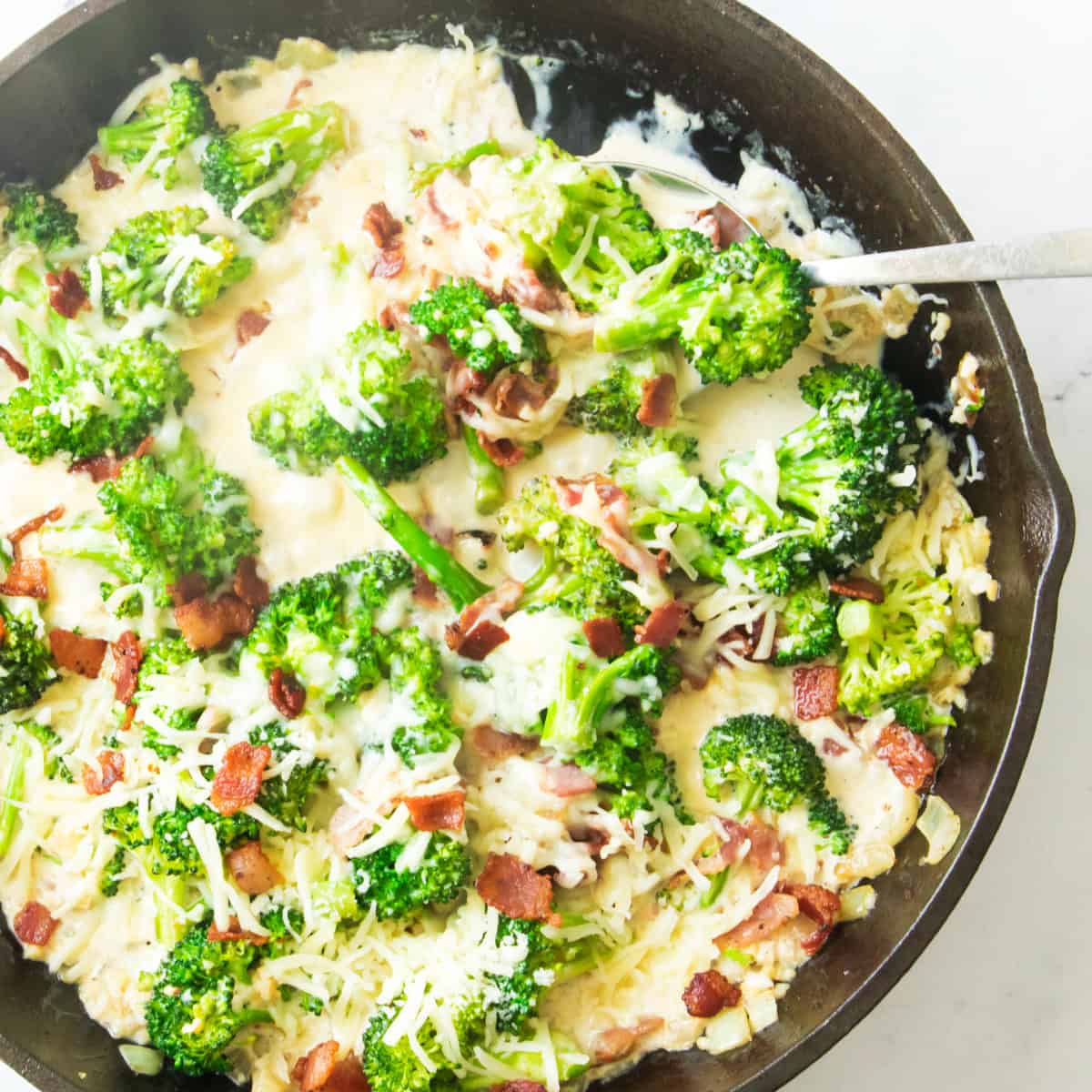
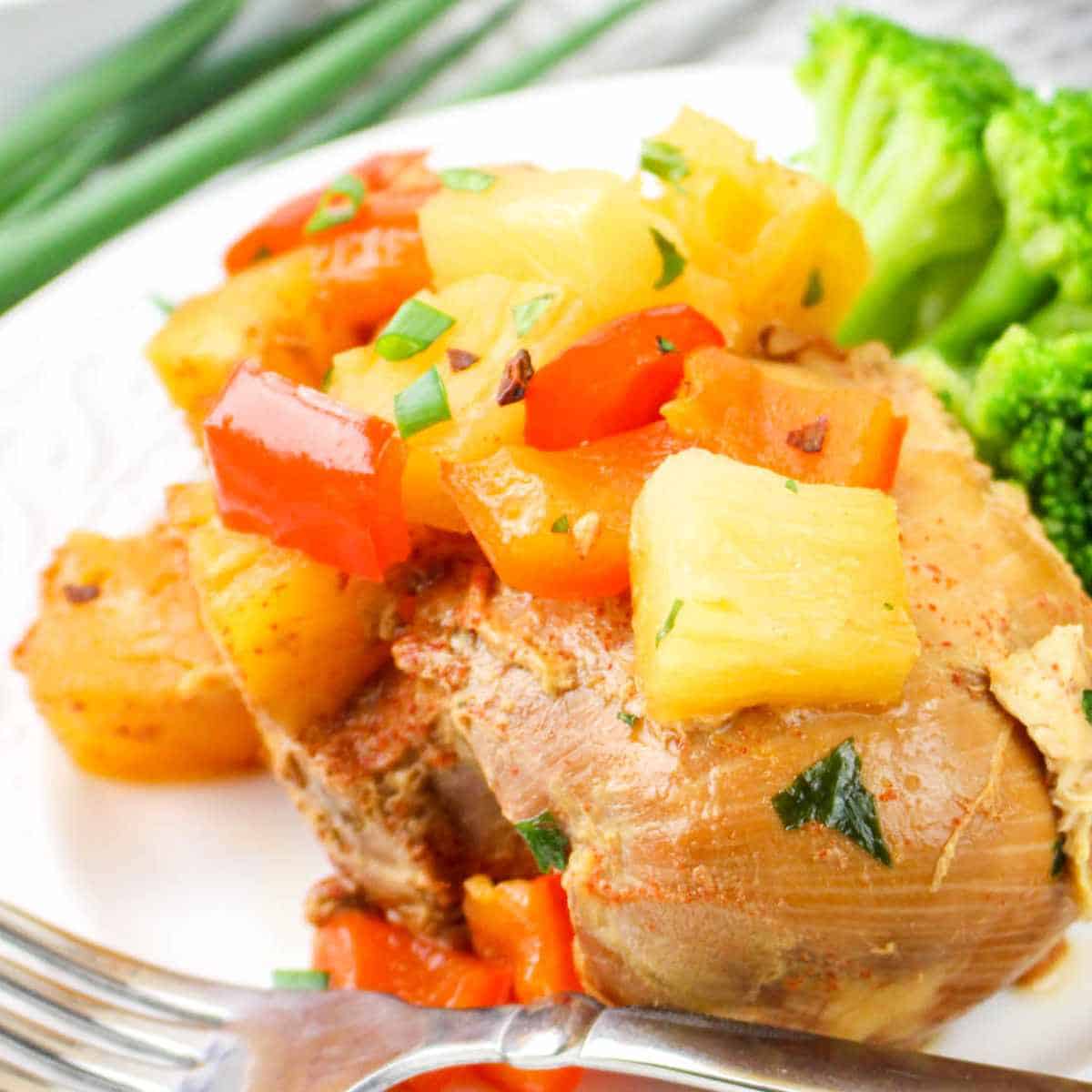

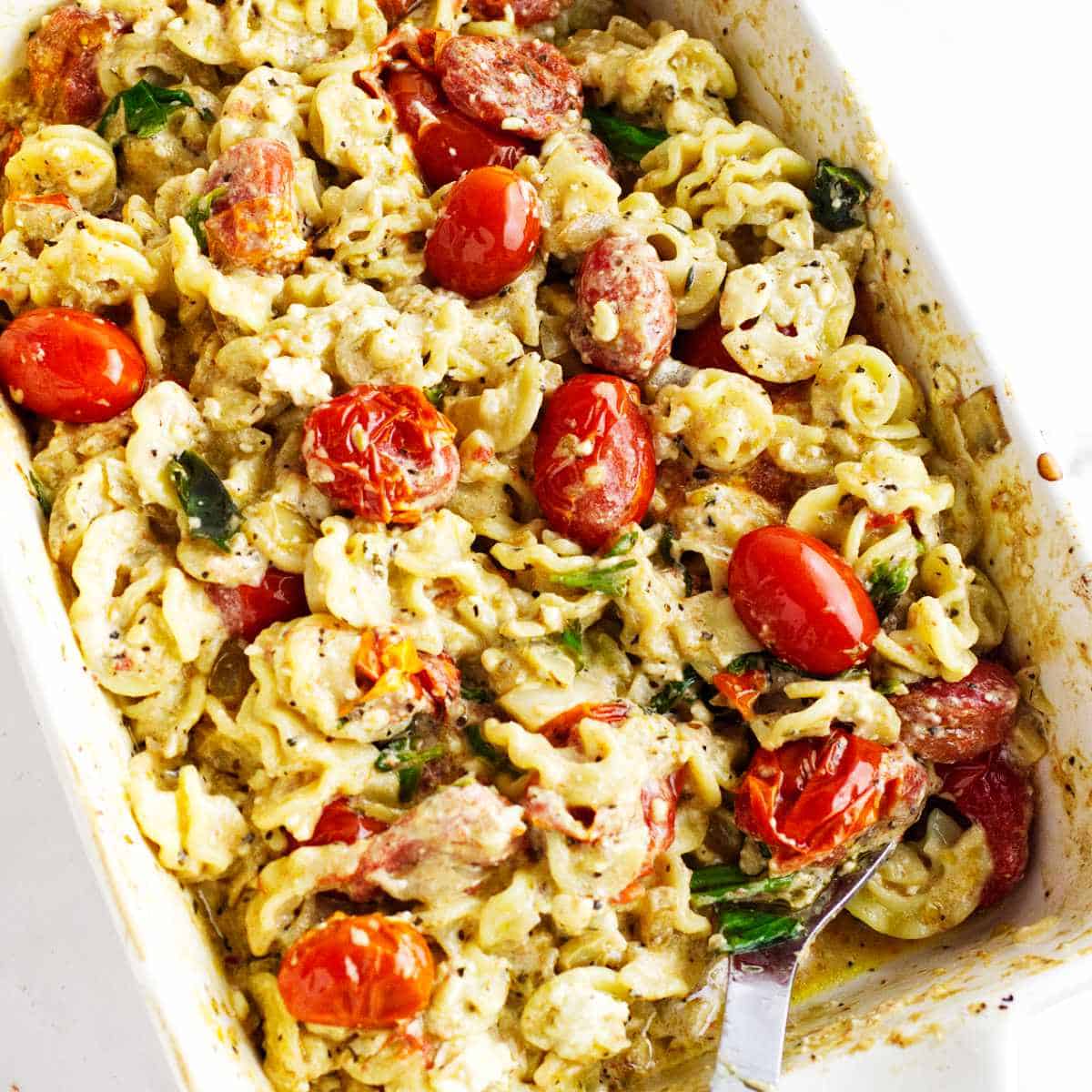
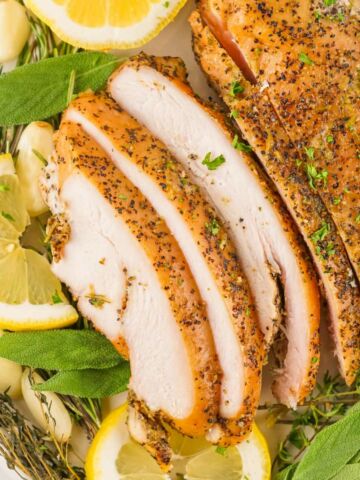

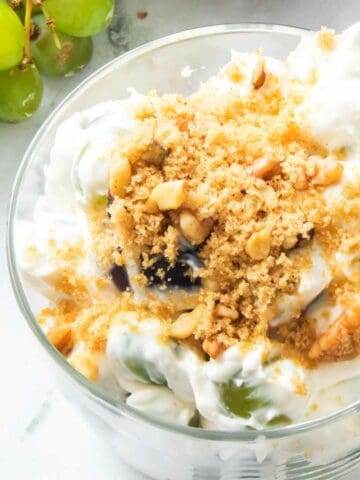
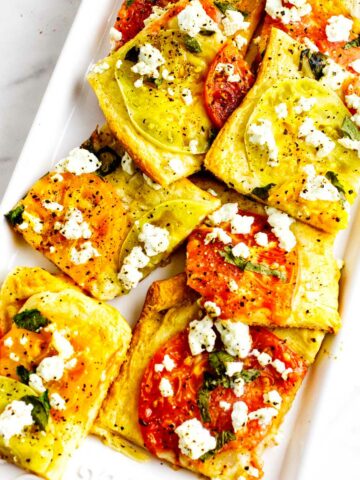
Leave a Reply